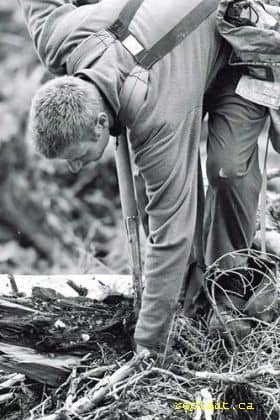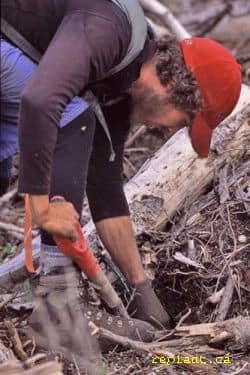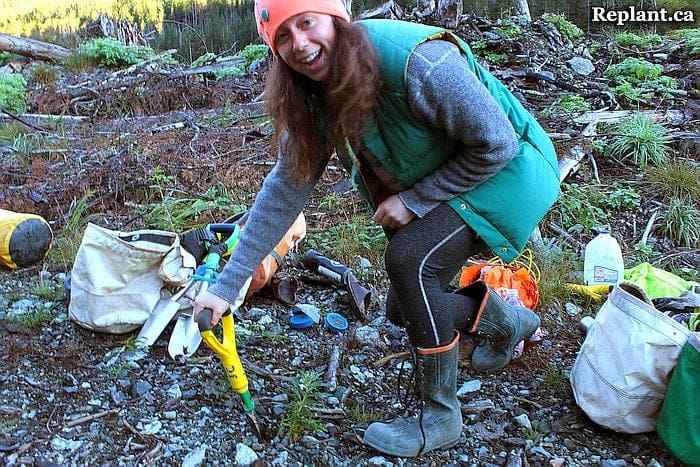 You would think that tree planting mostly depends on brute force, but more of it depends on efficiency of movement, and the right drive. I’ve seen small-framed girls planting double or more the quantity of hard working and muscular males. I have planted for seven summers, two of them eight months long, and have usually found myself near the top of every crew, earning $250 a day. I often compared it to washing a mountain of dishes. You can stare at it disheartened and trudge your way slowly through it, or roll up your sleeves and get the job done asap. A lot of it is in your mind, and moaning and groaning about it will not only slow you down, but depress you at the end of the day, when it is time to count your tallies and earnings.
You would think that tree planting mostly depends on brute force, but more of it depends on efficiency of movement, and the right drive. I’ve seen small-framed girls planting double or more the quantity of hard working and muscular males. I have planted for seven summers, two of them eight months long, and have usually found myself near the top of every crew, earning $250 a day. I often compared it to washing a mountain of dishes. You can stare at it disheartened and trudge your way slowly through it, or roll up your sleeves and get the job done asap. A lot of it is in your mind, and moaning and groaning about it will not only slow you down, but depress you at the end of the day, when it is time to count your tallies and earnings.
I’d say there are several factors which can help you plant many trees per day:
-
the speed at which you plant each tree, which mostly depends on efficiency of movement and an avoidance of any dilly dallying;
-
the speed at which you choose and get to your next plantable spot;
-
how well you are at maintaining this pace or rhythm, and at limiting your breaks during the day.
 To plant a fast tree, you want to make a good micro site selection. Your shovel is a tool which can be used in many ways. Such as a probe to help you find an optimum spot. You can poke the blade at the ground and learn to feel what it must be like underneath. Sometimes I’ve planted on very rocky ground, but by poking I could feel where the rocks were smaller, would give way a bit, and where I assumed it would be easier to wedge the blade into the earth. Other times you learn to read the ground by sight alone for more ideal spots, such as soft soil between the roots of a large stump, where you see a thin layer of moss over rounded earth – an indication of moister and softer ground capable of supporting such thirsty vegetation.
To plant a fast tree, you want to make a good micro site selection. Your shovel is a tool which can be used in many ways. Such as a probe to help you find an optimum spot. You can poke the blade at the ground and learn to feel what it must be like underneath. Sometimes I’ve planted on very rocky ground, but by poking I could feel where the rocks were smaller, would give way a bit, and where I assumed it would be easier to wedge the blade into the earth. Other times you learn to read the ground by sight alone for more ideal spots, such as soft soil between the roots of a large stump, where you see a thin layer of moss over rounded earth – an indication of moister and softer ground capable of supporting such thirsty vegetation.
We should start this story at the point of planting the previous tree. While you are hunched over and burying your tree into the ground (or even while you were approaching the spot), you might have time to look around a bit, scan the ground, look for your other trees, and plan roughly where to plant your next tree.
While planting your previous tree and when you scan your horizon to plan the rough location of your next spot, you might notice that thin layer of green moss indicating that perfect and juicy microsite where you can plunge in your shovel with the least effort. You might also want to avoid some slash, by planting around it rather than waste your time clambering over it. Whatever your reasons, you want to choose your next spot so that it is the shortest distance away, so that it is a good micro site selection in terms of an easy spot to plant your shovel into, and along some path which will help you avoid as much clambering over slash as possible. Other times, when the slash is not piled up so high and easier to walk over, it might be better to line plant (explained on the next page).
 There are therefore two strategies you can take when filling in a certain area: line planting or area planting. Line planting is suitable for “easy ground” with few obstacles. In this case you can get into a good rhythm and pound in your trees, one after another, in an easy straight line not requiring much thinking or searching for your trees off of which to space your next ones. But if the slash is too high and obstructive, it may be better to break your line and fill in small areas instead, planting around slash to save time. When you first start planting it may be slow going for you as you stare at the mess around you and wonder what is the best strategy to take, but eventually your mind will respond instantly and automatically, without much thinking. Other times I like to follow the contour of the hill, to stay on the same horizontal and avoid tiring myself by walking up and down hills.
There are therefore two strategies you can take when filling in a certain area: line planting or area planting. Line planting is suitable for “easy ground” with few obstacles. In this case you can get into a good rhythm and pound in your trees, one after another, in an easy straight line not requiring much thinking or searching for your trees off of which to space your next ones. But if the slash is too high and obstructive, it may be better to break your line and fill in small areas instead, planting around slash to save time. When you first start planting it may be slow going for you as you stare at the mess around you and wonder what is the best strategy to take, but eventually your mind will respond instantly and automatically, without much thinking. Other times I like to follow the contour of the hill, to stay on the same horizontal and avoid tiring myself by walking up and down hills.
Therefore, as you fill in your piece with trees, sometimes you might fill in micro areas, other times you would bounce off your existing trees and slash, and still other times line plant larger and easier areas.
Whatever strategy you take, once you have selected your route and the rough location of your next tree, you want to move to that location quickly and efficiently with minimum movement. A planter once asked a super highballer how many times he bends up and down every day, jokingly expecting a very high number, since that planter planted 5000 or more trees a day. But the highballer jokingly responded “once”, meaning they are hunched over pretty well much of the day, darting to their next plantable spot like a spider close to the ground. For such a fast planter there is no time to stand erect and walk graciously to the next spot.
 As you slither efficiently towards your next spot immediately after successfully planting your previous tree, you already want to be fumbling in your bag for your next tree, so that it is properly positioned in your planting hand and ready to deliver. Your shovel hand raises. You approach your next spot and already plan where you will take your first plunge. Hopefully your choice will be a good one and the blade sinks deep enough into the ground with minimal effort. Other times you may have to place your foot on one of the kickers (the top horizontal part of the blade) to help force the blade into the ground. Or use two hands on the handle to wriggle it in. Simply keep holding onto your unplanted tree while doing so.
As you slither efficiently towards your next spot immediately after successfully planting your previous tree, you already want to be fumbling in your bag for your next tree, so that it is properly positioned in your planting hand and ready to deliver. Your shovel hand raises. You approach your next spot and already plan where you will take your first plunge. Hopefully your choice will be a good one and the blade sinks deep enough into the ground with minimal effort. Other times you may have to place your foot on one of the kickers (the top horizontal part of the blade) to help force the blade into the ground. Or use two hands on the handle to wriggle it in. Simply keep holding onto your unplanted tree while doing so.
Or after attempting to plunge the blade into your chosen micro site, you might decide it was not the best one and prod further. You have to quickly calculate whether it will be more prudent to keep struggling with the present choice, or move on to better pasture.
Either way, once you have dedicated yourself to a particular spot, you want the shovel blade deep enough in the ground to allow for a straight plug. If your plug is not straight the checker might dig it up and fail you for it.
Speaking of fail…

Next: |
We are a family operation managing private custom boat tours in the beautiful Palawan area, and are happy to help travelers with their plans through the country, having traveled a lot of it ourselves and planning to visit it all. The pages in this section concern when I was treeplanting in Canada over eight summers.
